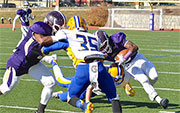- Skip Storing This Everyday Product in the Fridge Door
- Green Tea + B3 Pairing May Boost Brain Health
- Navigating Your Midlife Crisis: Embracing New Possibilities
- City Raccoons Showing Signs of Domestication
- Mapping the Exposome: Science Broadens Focus to Environmental Disease Triggers
- One Week Less on Social Media Linked to Better Mental Health
- Your Brain Changes in Stages as You Age, Study Finds
- Some Suicide Victims Show No Typical Warning Signs, Study Finds
- ByHeart Formula Faces Lawsuits After Babies Sickened With Botulism
- Switch to Vegan Diet Could Cut Your Greenhouse Gas Emissions in Half
Just One Season of Hits in High School Football May Alter Brain: Study


Even among high school football players who’ve never had a concussion, a small preliminary study suggests that changes can still occur to their brains within the course of a single season.
The study involved 45 members of a 2012 varsity team. Players underwent two brain scans — one before and one after the season — with a special type of MRI.
Throughout the season, each player wore a helmet fitted with an accelerometer device. “It’s able to capture linear and rotational accelerations that can then be used to figure out what forces have been applied to the head,” said study author Dr. Alexander Powers, an assistant professor of neurosurgery, pediatrics and orthopedics at Wake Forest Baptist Medical Center.
The telemetry system used in the study transmits real-time data to researchers on the sideline. “During the season, we captured every single hit. Every practice, every game,” Powers said.
None of the players suffered a concussion. Yet, the more total hits a player had received to the head, the more changes that were measured in the white matter of his brain, the study found.
It’s too soon to make conclusions from one U.S. high school football squad among the more than 14,000 that compete each year. And the study doesn’t show whether the brain changes are temporary or permanent, or how they might affect players’ lives.
The white matter “is essentially the conduction part of the brain,” said Powers. “The fact that we do have this abnormality in the white matter that correlates so well with the amount of hits that kids had is really striking.”
On a personal level, he said football “teaches some great lessons,” and two of his sons now aged 10 and 12 have played youth football. “But here’s the thing,” Powers said. “I will not let them play high school football.”
He is to present the findings Tuesday at the annual meeting of the American Association of Neurological Surgeons, in San Francisco.
One expert not involved with the study described the “almost gladiatorial” nature of football and said the study “raises new concerns.”
“I think the current discussion about concussion and young athletes says, ‘Well, yes, the kids get concussion in football but they get it in a lot of other sports too, such as soccer and hockey,’ etc.,” said Dr. Lyle Micheli, director of sports medicine at Boston Children’s Hospital and a clinical professor of orthopedic surgery at Harvard Medical School.
“The difference, however, is that this study raises the concern in a sport such as football, where much of the tactic of the game is to hit with your head,” Micheli said, and that “this sport in its very nature is going to increase the chance of getting traumatic brain injury.”
While Micheli added that “this scientifically is a very sound study,” he noted that as a meeting presentation, it has not yet gone through the peer-review process it must to be published in a medical journal. “I do think it’s publishable [and] will be submitted to a journal and will be accepted, I’m sure,” he said.
“It doesn’t show cause and effect, but it shows an association that is very concerning,” Micheli said.
There are ways to minimize the threat to young football players, both experts noted.
“We found that the majority of exposure for most of the kids is during practice,” Powers said. “The low-hanging fruit is limiting practice, limiting hitting in practice, limiting drills.”
He commended Little League baseball for limiting pitch counts to prevent shoulder injuries.
In youth football, he said, “I’d like to see something similar with head impacts, where we figure out the number of impacts that one can safely be exposed to, and I use the term ‘safely’ loosely here because all it takes is one hit to generate a concussion.”
Micheli said that the key is coaching and officiating, including “better enforcement of rules against late head hits.”
In rugby, for example, with dangerous play, “you get a red card, you’re thrown out of the game,” Micheli said. “And your team plays one [player] down. That’s got real teeth in it.”
To extend the findings, Powers will analyze a new batch of data from the football team’s 2013 season.
The researchers plan to look at whether the brain is able to heal itself, or whether it loses that ability at some point.
More information
Visit the U.S. Centers for Disease Control and Prevention to learn more about concussion in sports.
Source: HealthDay
Copyright © 2025 HealthDay. All rights reserved.










